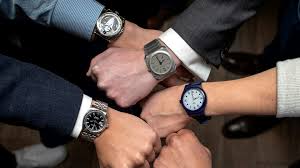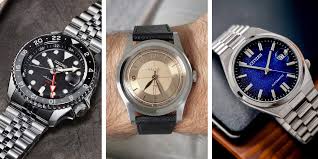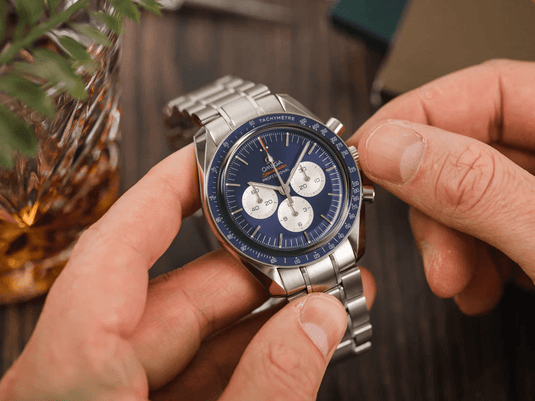Watches are more than just time-telling tools—they're personal style statements, heirlooms, and sometimes even status symbols. But knowing how to wear a watch properly is key to making the most of its functionality and aesthetic value.
From choosing the right wrist to matching your watch with your outfit, understanding watch etiquette, and ensuring proper fit, this guide will help you master the art of wearing a watch with style and confidence.
1. Which Wrist Should You Wear Your Watch On?
✔ The Traditional Answer:
Most people wear their watch on their non-dominant hand. So, if you're right-handed, you’d typically wear your watch on the left wrist. If you're left-handed, the right wrist is usually preferred.
Why the Non-Dominant Hand?
-
Comfort: Your dominant hand does more work, so the watch won’t interfere with your activities.
-
Protection: Less exposure to impact or scratches.
-
Ease of Use: If your watch has a crown (the knob used for setting time), it’s usually placed on the right side of the case—easier to access with your dominant hand.
That said, there's no hard rule. It’s all about personal comfort and preference.
2. How Tight Should a Watch Fit?

A well-fitted watch strikes a balance between comfort and security.
✅ Ideal Fit:
-
Snug but not tight: Your watch should sit just above your wrist bone and not slide more than an inch when you move.
-
No red marks: If your watch leaves an impression on your skin, it's too tight.
-
No flopping: If it slides down to your hand, it’s too loose.
For Metal Bracelets:
Adjust the links or use micro-adjustment holes on the clasp.
For Leather Straps:
Choose the notch that feels snug but not restrictive.
3. How to Match a Watch With Your Outfit

Your watch should complement your attire, not clash with it. Here’s how to match it appropriately:
🎩 Formal Attire (Business or Black Tie):
-
Go for dress watches: Simple, slim, and elegant.
-
Strap: Leather is ideal, typically black or brown.
-
Case: Slim, minimal, in silver or gold.
-
Dial: Classic, clean look—white, black, or navy.
👔 Business Casual:
-
Chronograph or dress-casual hybrids work well.
-
Match strap material to shoes or belt.
-
Avoid overly sporty or large-faced watches.
👕 Casual Wear:
-
Field watches, diver watches, or sporty chronographs work great.
-
You can wear NATO, rubber, or canvas straps.
-
Play with colors and designs for a relaxed look.
🧥 Outdoor/Active Gear:
-
Digital or tactical watches with GPS, altimeters, or rubber straps.
-
Durability and function over form.
4. Choosing the Right Watch for Your Wrist Size

Proportions matter. A watch should look balanced and comfortable on your wrist.
Measure Your Wrist Circumference:
-
Small (6"–6.5"): Look for case diameters of 34–38mm.
-
Medium (6.5"–7.5"): 38–42mm watches are ideal.
-
Large (7.5"+): You can pull off 42–46mm or more, depending on your style.
Consider Watch Case Thickness:
-
Thicker cases suit larger wrists.
-
Slim watches look better on narrow wrists and slide more easily under dress shirt cuffs.
5. When (and When Not) to Wear a Watch

✔ Good Times to Wear a Watch:
-
Meetings and interviews
-
Weddings, dinners, and formal events
-
Daily work
-
Travel (especially with GMT watches)
-
Fitness or sports (with a digital or sport watch)
❌ Times to Avoid Wearing a Watch:
-
In the shower or pool—unless it’s water-resistant or a dive watch
-
During heavy lifting or construction work (unless using a durable G-Shock or tool watch)
-
With black tie if the watch is bulky or casual (slim dress watches only)
6. Watch Etiquette: Dos and Don’ts
Wearing a watch involves more than putting it on—it’s also about how you carry it socially.
✅ Do:
-
Wear your watch on the inside of your wrist bone.
-
Match metals and leather to your other accessories (belt, shoes, rings).
-
Take care of your watch: clean it regularly and get it serviced.
-
Use subtle glances to check the time—don’t make it obvious or rude.
❌ Don’t:
-
Wear a smartwatch with formalwear unless it's stylish and sleek.
-
Let your watch dangle or flop around.
-
Flash it unnecessarily—it comes off as tacky.
-
Overstack with too many bracelets unless you're going for a specific fashion statement.
7. Types of Watches and When to Wear Them
Understanding watch categories can help you wear the right one at the right time.
🕴 Dress Watch
-
Thin, elegant, minimalist.
-
Ideal for suits, weddings, black-tie events.
🌊 Dive Watch
-
Rugged, water-resistant, often has a rotating bezel.
-
Casual, travel, and water-based activities.
⌚ Field Watch
-
Military-inspired, simple dial, durable.
-
Great for outdoor activities, hiking, or everyday wear.
🔧 Chronograph
-
Stopwatch functionality, sporty, bold.
-
Works for business casual, smart casual, or car/racing-related events.
🌍 GMT/World Timer
-
Displays multiple time zones.
-
Excellent for travelers or global business.
💪 Smartwatch
-
Fitness tracking, apps, and notifications.
-
Best for daily wear, work, or workouts—but less ideal for formal occasions.
8. Layering a Watch with Other Accessories
If you wear bracelets, consider these tips:
-
Keep metals consistent (silver with silver, gold with gold).
-
Don’t stack more than 1–2 bracelets with a watch.
-
Place the watch closest to your hand, then stack bracelets above.
-
Match strap material to your bracelet style—leather with leather, fabric with casual beads, etc.
9. Left or Right Hand: Does It Matter?
While tradition leans toward the non-dominant hand, some people prefer the opposite. Here are the pros and cons:
| Wrist | Pros | Cons |
|---|---|---|
| Left | Traditional, easier for right-handers | Harder to operate crown if left-handed |
| Right | Better for left-handers | Watch design might be awkward (crown placement) |
Ultimately, it’s a matter of preference and comfort.
10. Caring for Your Watch While Wearing It
Regular Maintenance:
-
Wind automatic or manual watches as needed.
-
Clean the strap and case gently with a microfiber cloth.
-
Avoid perfumes or lotions that can damage leather or rubber straps.
Strap Rotation:
-
Rotate between different straps (leather, NATO, metal) to reduce wear and extend lifespan.
Final Thoughts: Wearing a Watch With Intention
Wearing a watch is more than just strapping something to your wrist—it’s about expressing personal style, appreciating craftsmanship, and sometimes even honoring tradition.
Whether you’re new to the world of watches or a longtime enthusiast, learning how to wear a watch properly can elevate your overall look and help you feel more confident and polished. Choose one that fits your lifestyle, wear it with pride, and treat it with care—and your watch will do more than tell time; it will tell your story.


